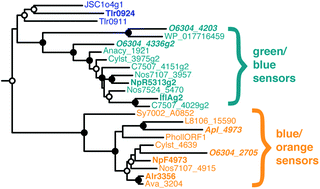Identification of DXCF cyanobacteriochrome lineages with predictable photocycles†
Abstract
Diverse organisms use phytochrome photoreceptors to measure the ratio of red to far-red light in their respective environments. In addition to red/far-red phytochromes, many cyanobacteria contain distantly related cyanobacteriochrome (CBCR) photosensors that also use photoisomerization of a covalently bound linear tetrapyrrole (bilin) chromophore to measure multiple colors of light. CBCRs exhibit a remarkable variety of photocycles spanning the near ultraviolet and the entire visible spectrum. One group of CBCRs, distinguished by the presence of a conserved Asp-Xaa-Cys-Phe (DXCF) motif or variations thereon, includes members with violet/green, blue/teal, blue/green, blue/yellow, blue/orange, green/blue and green/teal photocycles. To date, it has not proven possible to predict such photocycles from primary amino acid sequence. We here use site-directed mutagenesis, phylogenetic analysis, and characterization of six new CBCRs to probe structure/function relationships in DXCF CBCRs. This approach has defined two groups of DXCF CBCRs with specialized green/blue and blue/orange photocycles that are robustly predictable from primary sequence data. Such knowledge facilitates the use of CBCRs for synthetic photobiological applications and informs approaches to understand the roles of CBCRs in cyanobacterial photobiology.


 Please wait while we load your content...
Please wait while we load your content...